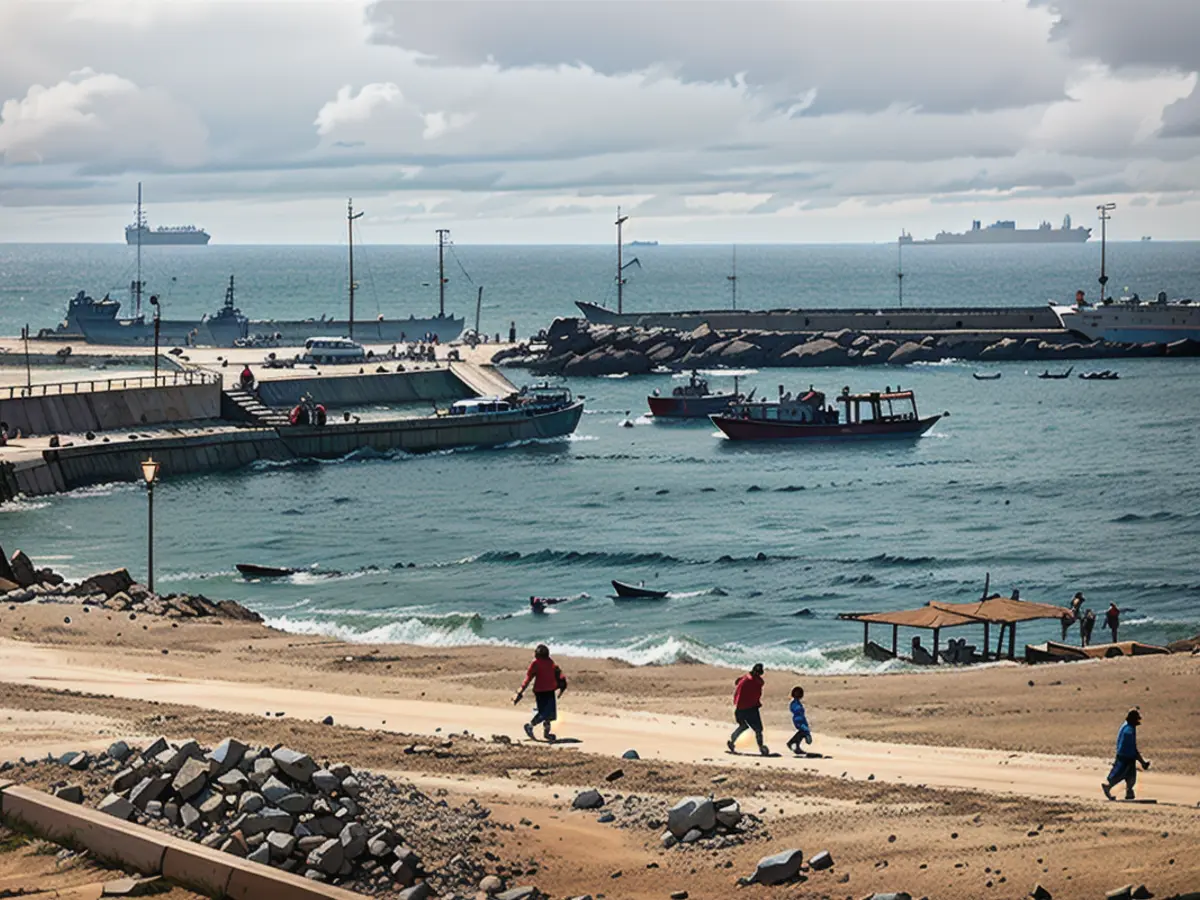Navigating rough waters: Uncovering the challenges behind America's plan to construct a pier in Gaza
By Tuesday, strong waves and an unforeseen North African storm had washed up four military vessels and caused substantial damage, so these had to be transported to Israel for mending.
A highly-placed government official expressed his dissatisfaction to CNN, noting that the jetty had been functioning well enough that authorities were prepping to increase the support sent via it.
The jetty symbolizes months of work by officials trying to devise a method to transfer aid to Gaza without parachuting it from planes or transporting it through border checkpoints. Whilst it was in operation for about a week, the jetty aided in transporting approximately 1,000 metric tons of aid to Gaza before disintegrating.
This falls short of the military's target for shifting 500 tons of aid daily over the jetty. Additionally, initial delays obstructed distribution of the aid that arrived in Gaza. The jetty also entailed a significant cost of $320 million and necessitated the involvement of 1,000 US military staff to finish its construction before its disintegration last week.
However, with air drops decreasing lately, and the route into Rafah currently closed, the jetty is still a potential conduit for thousands of Gazans stricken by a humanitarian crisis.
Biden officials express optimism that it can be successfully mended and restored within weeks. Nonetheless, substantial concerns persist concerning the jetty's reliability, spurring the administration to avoid deploying it several months back.
Several US officials spoke to CNN, elaborating on the months of planning, initiatives, and problem-solving executed to build the jetty and the ongoing attempts to reexamine and sustain its operation.
Nearly a decade out of service
In late October, US Central Command officials raised the prospect of constructing a temporary jetty off the Gaza coast, the senior administration official informed CNN. They judged the risks to be too severe at the time, given the unforeseeable winter weather and violent clashes in Gaza.
The jetty was similarly inadequate at navigating rough seas.
During an extensive military exercise in Australia last year, US troops required a "narrow window" of suitable conditions to deploy the jetty due to turbulent seas. They also encountered such problems during a training event off the Virginia coast in 2016.
It's also over a decade since the military employed this type of floating jetty - known as a Joint Logistics Over-the-Shore (JLOTS) system - in a real operation, when it transported humanitarian aid to Haiti following the catastrophic 2010 earthquake.
A defense official shared with CNN that it's "something we haven't done in a really long time."
"We assumed a lot of risk by utilizing a military operation for this purpose," commented a second senior administration official. "We've carried out these types of operations before, but this capability isn't normally used for these scenarios, leading to a distinct dynamic."
Doubt over maintenance
There are inquiries about the level of care the Army takes while maintaining watercraft utilized in JLOTS missions. Speaking to CNN anonymously, a warrant overseer who once served as the chief engineer operating on Army watercraft criticized the effectiveness of the capability, claiming that the Army has for a long time undervalued the task of employing the floating pier and hasn't dedicated adequate resources towards it.
"Army boats have not been prepared, ready, or in a mindset they'll have to face challenges in the real world ... for ages now," the retired engineer said.
Another US official acknowledged that these watercraft executing JLOTS missions have not been maintained "to the extent they need to be," primarily due to "not being able to procure the replacement parts fast enough."
These replacement parts are also difficult to source. The US official stated that they're seldom off-the-shelf items like one can find for some Army machinery.

"These vessels are ancient," the US official said, also mentioning that just before the vessels were sent to Gaza, soldiers were still working on repairs on one of them.
The retired engineer was more critical, asserting that rust on the vessels "is not eradicated, parts are not really repaired, the vendors that deliver the parts ceased to exist so it's an issue to get replacements when they're required."
When CNN inquired about the Army's resource allocation for its watercraft, Army Secretary Christine Wormuth stated she thought the Army had invested sufficiently.
"The JLOTS capability is a fantastic capability and I believe it has vast potential, but it was never intended to manage in these high seas," she said, adding that they anticipate the rough seas in which JLOTS was anchored to settle "in a few days."
The subject of creating a maritime passage first surfaced during the closing weeks of October, according to a government source. This revelation was made during a foreign affairs council meeting described as being quite general but without any specifics about funding or construction being detailed. The United States did not attend this gathering, but learned about it through other nations present, such as France and the UK.
Since then, the feasibility of a floating pier was debated. It was initially considered too risky considering the ongoing Israeli military operations and the questionable weather conditions at that time of the year. However, as the urgency for humanitarian assistance intensified during January and February, officials reassessed the situation.
American officials engaged their counterparts in Cyprus and Israel to investigate the possibility of using the temporary pier as a staging area for providing aid distribution.
Following this, Prime Minister Benjamin Netanyahu revisited the idea during discussions with US officials. As a result, the Pentagon was asked to appraise the project once more. A significant concern was the contention for Pentagon resources: besides the hefty financial costs, this project would also necessitate a sizable number of American personnel for its successful execution.
Parallel to the pier investigation, airstrikes of humanitarian aid were carried out by the US military, providing over 1,200 tons of food and aid. However, these airdrops were not entirely safe. Recently, at least five individuals were reported dead after being struck by airborne packages. Additionally, about a dozen Palestinians drowned while attempting to reach supplies that were dispersed in the sea near Gaza.
On the first of March, the United States gave the go-ahead for the floating pier, presaging President Joe Biden's announcement in his State of the Union address that the military would be tasked with erecting this temporary structure along the Gaza coastline.
Notwithstanding its challenges, officials remained optimistic about the pier's role in continuing to channel aid into Gaza, a region now in the grips of what they characterize as a "full-blown famine."
Spokespersons from the State Department and the Pentagon issued statements recognizing its value as part of a broader humanitarian initiative.
As of now, all pieces of the pier have been moved to Ashdod, Israel. Here, military specialists mentioned that they would require replacing some of the pins that secure the pier and, weather-permitting, carrying out welding repairs on the structure.
Yet, it is unclear how the military would adapt to conditions that might be more treacherous later in the year. There are discussions about extracting the pier if rough weather is apparent. However, this might involve relocating it from the beach and correctively re-anchoring it.
"The chief priority now is to see that this doesn't take place again," a military source said.
However, these officials have been uniform in emphasizing that Israel's opening more land border crossings is the optimal method to deliver aid to Gaza.
After affirming the pier's merit as an auxiliary strategy, Pentagon spokesperson Sabrina Singh reiterated the belief that the primary solution is through land routes: "It is not the solution [the pier]. And so I just have to remind you that the best way for food, medication, fuel - any aid - to enter Gaza is through those land routes."

Read also:
Despite the expressed optimism from Biden officials, concerns remain about the jetty's reliability, leading to the administration's initial hesitation to deploy it several months ago.
The construction of the jetty, a JLOTS system last used a decade ago, involved watercraft that have not been adequately maintained, according to some US officials.






